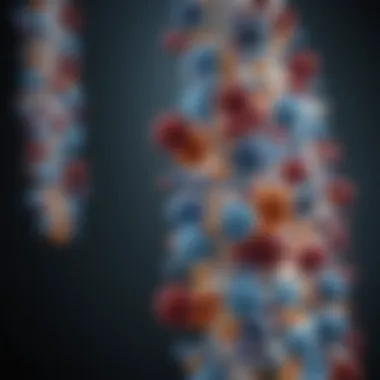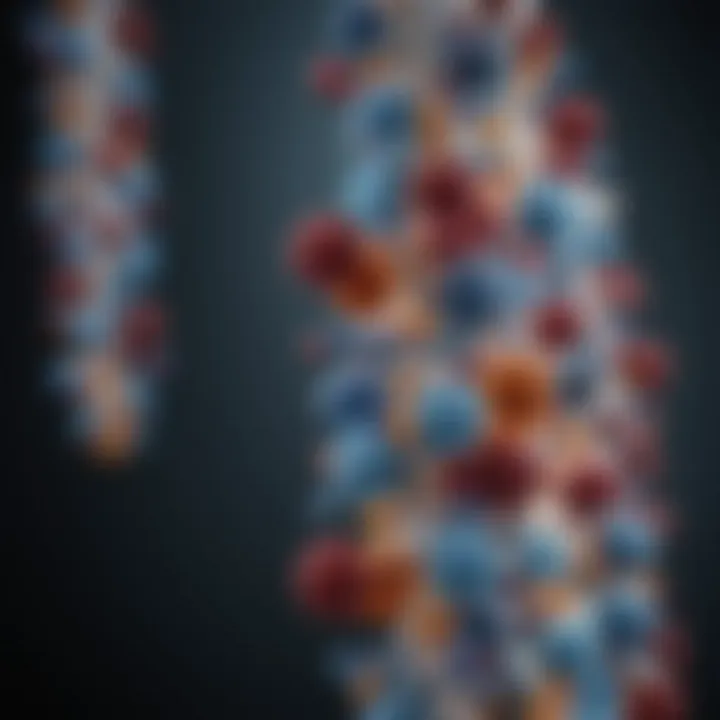The Light Chains of Antibodies Explained


Intro
The light chains of antibodies play a crucial role in the immune response. Understanding their structure and function is essential for grasping how antibodies work. Every antibody is made of two different types of chains: heavy chains and light chains. The light chains are smaller and contribute to the overall structure, but their importance in binding to antigens cannot be overstated.
The following sections will explore the specifics of light chains, including their unique characteristics, the mechanisms behind their diversity, and the implications of their function in health and disease. This exploration aims to provide a comprehensive view of the essential role that light chains play in the immune system.
Research Highlights
Overview of Key Findings
- Light chains consist of two main types: kappa and lambda. Each type is encoded by distinct genes and is critical for proper antibody structure and function.
- The variability in light chains contributes to the diversity of antibodies, allowing the immune system to recognize a wide range of pathogens.
- Abnormalities in light chain production can lead to various diseases, including multiple myeloma and other lymphoproliferative disorders.
Significance of the Research
Research on light chains is significant in several ways. It helps to understand the basic functions of the immune system. Analyzing how light chains interact with heavy chains reveals insights into antibody effectiveness. Moreover, detecting light chain abnormalities can aid in the diagnosis of certain diseases, making it a key area for clinical research and application.
End
The light chains of antibodies are more than structural components. They are vital for the immune system's ability to function effectively against various pathogens. As research evolves, the implications of understanding light chains are likely to expand, offering new pathways for therapeutic interventions and diagnostic tools. This article aims to deepen knowledge and shed light on the significance of these fascinating molecules within our immune response.
Intro to Antibodies
Antibodies are fundamental components of the immune system, crucial for identifying and neutralizing pathogens such as bacteria and viruses. Understanding them is not only essential for biologists and medical professionals but also for advancing therapeutic strategies against various diseases. This section will illuminate some key elements about antibodies that set the tone for deeper exploration into the specifics of light chains.
Antibodies are primarily made of protein and can be classified based on their structure and function. They possess the remarkable ability to recognize an extensive range of antigens due to their diverse binding mechanisms. The introduction of this complex system allows for a better grasp of how light chains, which are lighter in molecular weight than heavy chains, play a role in forming functional antibodies.
Antibodies consist of two heavy chains and two light chains, with the latter crucial in determining specificity and binding affinity.
Overview of Antibody Structure
The structure of antibodies is a remarkable feat of nature, comprising four polypeptide chains. Two of these chains are heavy, while the other two are light. Each chain contains a series of domains that fold into distinct structures. The variable regions at the ends of the chains form the antigen-binding sites, allowing antibodies to bind specifically to unique antigens. The constant regions, on the other hand, interact with other components of the immune system. This separation of duties contributes to the antibodies' capability to mount a robust immune response.
Light chains can be classified into two types: kappa and lambda. The balance between the two types is assumed to be important for healthy immune function. Any imbalances can signify underlying health issues. This foundational understanding of antibody structure is essential for appreciating the role of light chains, revealed in the subsequent sections.
Classification of Antibodies
Antibodies can be classified into five main classes based on their heavy chain structure: IgG, IgA, IgM, IgE, and IgD. Each class has distinct roles within the immune system.
- IgG is the most abundant, providing the majority of antibody-based immunity against invading pathogens.
- IgA is mainly found in mucosal areas, like the gut and respiratory tract, helping to prevent pathogen entry.
- IgM is the first antibody to be produced in response to an infection, playing a critical role during the initial stages of immunity.
- IgE is involved in allergic reactions and responses to parasitic infections.
- IgD generally serves as a receptor on B cells, but its exact role in the immune response is still being researched.
Each class of antibody serves a unique function and works in synergy with light chains to orchestrate an effective immune response. Understanding these classifications is a vital step towards grasping the complexities of light chains and their influence on antibody function.
Understanding Light Chains
Understanding the light chains of antibodies is crucial in the study of the immune system. Light chains play a significant role in the overall structure and function of antibodies, which are proteins essential for immune response. Their primary purpose is to bind to antigens, while the heavy chains provide structural support.
A deep understanding of light chains enhances our grasp of how antibodies recognize and neutralize pathogens. This comprehension has direct implications for clinical practices such as diagnostics and therapeutics. The light chains contribute not only to binding affinity but also to the specificity of antibodies, determining how effectively they can interact with various antigens.
The study of light chains also delves into genetic factors. Light chain isozymes, kappa and lambda, emerge from specific gene segments, influencing the immune response's variability. Understanding these elements allows researchers to uncover how disruptions in light chain production can lead to diseases such as multiple myeloma and light chain amyloidosis.
Importantly, light chains are a focal point in diagnostic medicine. Tests to quantify light chain levels offer insights into various medical conditions, aiding in timely interventions and treatments. By grasping light chain dynamics, medical professionals can make better-informed decisions in patient care.
Thus, a thorough exploration into light chains reveals their pivotal role in immunology, impacting both fundamental knowledge and practical applications in clinical settings.
Definition and Composition


Light chains are small polypeptide chains that form an integral part of antibody structure. Each antibody molecule consists of two light chains and two heavy chains. The light chains, which have a molecular weight of approximately 25 kDa, are classified into kappa (κ) and lambda (λ) types, with both types playing similar functional roles in immune processes.
The composition of light chains includes a variable region and a constant region. The variable region differs between antibodies, allowing for a diverse array of antigen recognition. These unique sequences contribute to the ability of antibodies to target specific pathogens or foreign materials. The constant region, however, remains relatively unchanged within a type of light chain, providing stability.
The synthesis of light chains happens in plasma cells derived from B lymphocytes. The genes encoding light chains are located on chromosome 22 for kappa chains and chromosome 22 for lambda chains. The structure of light chains is crucial for their interaction with the antigen-binding site of the antibody, thus influencing the antibody's overall effectiveness.
Heavy Chain vs. Light Chain
The distinction between heavy chains and light chains is fundamental in understanding antibody functions. Heavy chains are larger, generally about 50-70 kDa in size, and they possess a more complex structure, which allows them to contribute significantly to the antibody's stability and distribution within the body.
Both chains form the Y-shaped structure of antibodies, but their functions diverge. Light chains primarily handle the antigen-binding aspect. In contrast, heavy chains interact with cellular receptors and facilitate effector functions such as complement activation and binding to Fc receptors on immune cells.
The presence of different heavy chain types—IgG, IgA, IgM, IgD, and IgE—coupled with the two variants of light chains allows for a broad range of antibody specificity and function. The heavy chain's diversity further impacts the antibody's effector profile, influencing immune responses.
Genetics of Light Chains
The genetics of light chains is a crucial aspect in understanding the diversity and functionality of antibodies. This section offers an insight into how light chains are orchestrated at the genetic level. It sheds light on their structure and the mechanisms that allow for the vast array of antibodies the immune system produces. A comprehensive evaluation of genetic factors also emphasizes the intricacies involved in antibody formation, which is essential for both research and clinical applications.
Gene Localization and Structure
The genes for light chains, specifically the immunoglobulin light chain genes, are located on chromosomes 22 and 2 for lambda and kappa light chains, respectively. These chromosomes harbor clusters of genes that are essential for producing the two types of light chains found in antibodies. The arrangement of these genes is not random. Instead, they are organized in a way that facilitates the recombination required for generating diverse antibodies.
Each light chain gene consists of distinct segments, including Variable (V), Diversity (D), and Joining (J) segments. The variable regions primarily determine the antigen binding specificity of the antibody. There are separate loci for kappa and lambda light chains. The structure is designed to enable a selection process during the early stages of B-cell development, guaranteeing that only functional light chains undergo further assembly into the full antibody molecule.
()J Recombination
V(D)J recombination is a fundamental process in generating the diverse repertoire of antibodies. This genetic rearrangement takes place during B cell maturation. It is essential because it allows for the random assortment of V, D, and J segments to create unique light chain sequences. Through this process, each B cell can express a different light chain, contributing to an extensive library of antibodies capable of recognizing various antigens.
The enzyme RAG (Recombination-Activating Gene) plays a critical role in this process. RAG proteins initiate the recombination by binding to specific recombination signal sequences adjacent to the V, D, and J segments. Once bound, they introduce double-strand breaks, enabling the pieces to be spliced together. This process can lead to multiple permutations of light chain sequences, significantly contributing to the adaptability and specificity of the immune response.
The significance of V(D)J recombination extends beyond mere genetic diversification; it is a tightly regulated process. Improper recombination can lead to non-functional antibodies or B cell malignancies. This aspect underscores the importance of proper genetic mechanisms in maintaining immune health and in preventing disease manifestations.
Functional Aspects of Light Chains
Light chains play a pivotal role in the functionality and efficacy of antibodies. Understanding these functions provides insights into how the immune system operates and responds to threats. The light chains, alongside heavy chains, form the structure of antibodies, allowing them to interact effectively with antigens. In this section, we will examine two significant aspects: their role in antigen binding and their influence on antibody specificity.
Role in Antigen Binding
The primary function of antibodies is to recognize and bind to antigens, such as pathogens or foreign molecules. Light chains contribute significantly to this capacity. Each antibody consists of two light chains and two heavy chains, and together they form an antigen-binding site. This site is uniquely structured to ensure that an antibody can selectively bind to specific antigens.
The variability in light chains is critical. There are two types of light chains, kappa and lambda, each with different genetic configurations. This diversity arises from the V(D)J recombination process, allowing B cells to generate unique antibodies tailored to various antigens. This mechanism increases the chances of a successful immune response by enabling antibodies to recognize an array of potential threats.
Additionally, the binding affinity of an antibody to an antigen is influenced by the light chain composition. This binding occurs due to the complementarity between the antibody's binding site and the antigen's surface, a fit that is determined primarily by the amino acid sequence of the light chains. The specificity of this interaction affects how effectively the immune system can neutralize pathogens.
"The significance of light chains in antigen binding cannot be overstated, as they are fundamental to the antibody's ability to recognize and respond to diverse threats."
Influence on Antibody Specificity
Antibody specificity is another essential aspect dictated by light chains. Each antibody is tailored to bind to a specific antigen, a feature that allows the immune system to distinguish between harmful pathogens and the body's own cells. The light chains are integral to this specificity, as they contribute directly to the formation of the unique antigen-binding site.
The combination of light and heavy chains results in a unique conformation that characterizes each antibody. Variability in the light chains is crucial in determining the overall structure and function. Mutations or modifications to the light chain genes can lead to changes in the binding properties of antibodies. Consequently, this can reduce or enhance their effectiveness against specific antigens.
It is also important to note that the interaction between light chains and antigens is not a static one. Environmental factors and the presence of other molecules may influence how these binding interactions take place. Thus, light chains do not simply facilitate attachment but actively participate in the dynamic response of antibodies to pathogens.
To summarize, light chains are essential in two significant ways: they enable antibody binding to antigens, ensuring specificity and efficiency in the immune response. Through their unique structures and genetic variability, light chains allow the body to mount an effective defense against a wide variety of pathogens, maintaining health and homeostasis.
Biochemical Pathways of Light Chain Synthesis


The biochemical pathways involved in light chain synthesis are vital to understanding antibody formation and functionality. These pathways encompass several processes that allow for the proper production of light chains, which are fundamental to the immune response. This section focuses on two crucial components: transcription and translation, alongside the important post-translational modifications that these light chains undergo.
Transcription and Translation
Transcription and translation are two key phases of protein synthesis. For light chains, these processes occur in specific cell types, primarily B cells.
- Transcription: During transcription, the genetic code within DNA is converted to messenger RNA (mRNA). This mRNA carries the necessary instructions for producing light chains. The genes responsible for encoding light chains are found on two distinct loci: the kappa light chain locus and the lambda light chain locus. The RNA polymerase enzyme plays a significant role in transcribing the DNA sequence into mRNA. This step is crucial as it ensures that the right light chain type is synthesized according to the B cell's requirements.
- Translation: Once mRNA is synthesized, it exits the nucleus and enters the cytoplasm where translation takes place. Here, ribosomes decode the mRNA to synthesize the protein chain. Transfer RNA (tRNA) molecules assist in bringing the appropriate amino acids to the ribosome, aligning them according to the mRNA sequence. This process results in the formation of a polypeptide chain that will fold into a functional light chain. The efficiency and accuracy of transcription and translation directly affect the overall immune response as they determine the abundance and functionality of the synthesised light chains.
Post-Translational Modifications
Post-translational modifications (PTMs) are crucial steps that occur after protein synthesis. They alter the structure and function of light chains significantly, enhancing their stability and activity. Common PTMs include:
- Glycosylation: The addition of carbohydrate groups helps in folding and stability of the protein. Glycosylation also plays a role in the immune recognition of antibodies.
- Phosphorylation: This modification can influence various signaling pathways and may affect light chain activity, impacting how antibodies interact with antigens.
- Proteolytic Cleavage: Certain modifications result in the trimming of additional peptide segments, which can be necessary for the protein to achieve its final functional form.
These biochemical modifications are not merely cosmetic; they are essential for the antibody's overall functionality. Allowing light chains to take on the appropriate conformation means they can perform their roles accurately in immune response.
Important Note: The quality of light chain synthesis is vital. Any errors in transcription, translation, or post-translational modifications can lead to structural abnormalities that affect antibody activity.
Clinical Significance of Light Chains
The clinical implications of light chains in antibodies are profound. Understanding the function and anomalies associated with light chains can provide vital insight in various medical conditions. Light chains are not just structural components; they play essential roles in immune response and pathogenesis of certain diseases. Awareness of these elements helps in developing targeted diagnostics and therapies.
Monoclonal Gammopathy
Monoclonal gammopathy is a condition where abnormal proteins, known as monoclonal proteins, are found in the blood. These proteins are derived from a single clone of plasma cells and can be composed of light chains or heavy chains. In cases where light chains are excessively produced, conditions such as multiple myeloma may arise.
This condition presents challenges in diagnosis and treatment. Most notably, the presence of free light chains in circulation indicates underlying disease processes.
- Symptoms and Diagnosis: Symptoms of monoclonal gammopathy can range from fatigue to bone pain. Physicians often assess serum and urine for light chain levels to diagnose the condition.
- Therapeutic Measures: Treatment typically involves addressing the underlying plasma cell disorder. Such interventions may include chemotherapy, monoclonal antibody therapies, and stem cell transplant.
- Monitoring: Follow-up with serum free light chain testing is crucial. This allows for monitoring of disease progression or remission.
Light Chain Amyloidosis
Light chain amyloidosis is a rare but serious condition characterized by deposits of amyloid proteins, which are formed from misfolded light chains. These deposits accumulate in organs, leading to dysfunction and damage. Organs commonly affected include the heart, kidneys, and liver.
- Symptoms: Symptoms vary based on the organs involved but can include swelling, fatigue, and heart-related issues. The varied symptomatology often complicates diagnosis.
- Diagnosis: Diagnosing light chain amyloidosis involves multiple assessments. Serum and urine protein electrophoresis are primary tools. Biopsy of affected tissues may also be necessary to confirm the presence of amyloid deposits.
- Treatment Options: Therapeutic strategies focus on reducing the production of the abnormal light chains. Chemotherapy regimens similar to those used in multiple myeloma are applied in many cases. Treatment can lead to improved outcomes by diminishing organ involvement and managing symptoms effectively.
In both conditions, a nuanced understanding of light chains enhances the diagnostic process. Monitoring and treatment adjustments rely heavily on light chain levels, making the study of these proteins essential in clinical settings.
Understanding the clinical significance of light chains is key for effective diagnosis and personalized treatment strategies in hematological disorders.
Current trends in research suggest that as technology advances, further insights into the behavior of light chains will emerge. This could lead to innovative diagnostic tools and therapies that improve patient outcomes.
Light Chains in Diagnostic Medicine
Light chains play a significant role in diagnostic medicine. Their measurement and analysis can provide valuable insights into various health conditions, particularly those related to the immune system. Through understanding how light chains function and their clinical implications, healthcare professionals can better diagnose and manage diseases such as multiple myeloma and light chain amyloidosis. This relevance cannot be overstated, as light chains serve as indicators of pathological states, helping to guide treatment decisions.
Light Chain Quantification Methods
Quantifying light chains is vital for accurate diagnosis and monitoring of diseases. Several methods exist for this purpose, each with its advantages and limitations. Common techniques include:
- Serum Protein Electrophoresis (SPEP): A technique that separates proteins based on their size and charge. This method can identify abnormal light chain levels but may not provide quantitative data.
- Immunofixation Electrophoresis (IFE): More specific than SPEP, IFE can detect and quantify the presence of monoclonal light chains by utilizing antibodies. It is especially useful in identifying specific light chain abnormalities.
- Free Light Chain (FLC) Assay: This immunoassay directly measures the free kappa and lambda light chains in serum. It is notable for its sensitivity and ability to detect imbalance in light chain production, which can indicate disease progression or response to therapy.
Each of these methods has a place in clinical practice and can help clinicians draw accurate conclusions regarding patient health based on light chain levels.
Clinical Applications and Case Studies
Understanding light chains also aids in addressing real-world clinical cases. Several specific applications showcase their importance:


- Diagnosis of Multiple Myeloma: In cases of suspected multiple myeloma, elevated levels of monoclonal light chains during FLC assays often lead to further investigations. Early detection of this cancer improves treatment success.
- Light Chain Amyloidosis: This condition results from the deposition of amyloid proteins derived from light chains. Accurate measurement and identification of the predominant light chain type (kappa or lambda) through IFE can inform treatment strategies.
- Monitoring Disease Progression: Regular quantification of light chains can help track the efficacy of treatment regimens in patients with plasma cell disorders. Shifts in light chain levels can signal relapse or necessitate changes in therapy.
By focusing on the quantification and analysis of light chains in diagnostic settings, clinicians can significantly enhance their approach to treatment and improve patient outcomes.
Light Chains and Therapeutic Interventions
Light chains of antibodies play a crucial role not only in the immune response but also in developing targeted therapeutic interventions. Understanding the implications of light chains can guide researchers and clinicians in creating effective treatment strategies, particularly for diseases linked with immune system dysregulation. This section will explore two significant avenues for intervention: targeted therapies and stem cell transplantation.
Targeted Therapies
The advent of targeted therapies marks a pivotal moment in medical treatments. These therapies are designed to interact with specific biological processes involved in disease progression. Light chains are particularly relevant in this context because they are implicated in various conditions where antibodies can be exploited for therapeutic purposes.
Light chain quantification can aid in establishing diagnostic criteria for diseases like multiple myeloma and amyloidosis. Understanding these dynamics is essential when developing targeted therapies that focus on light chains, especially in monoclonal gammopathy. Some therapeutic strategies utilize recombinant antibodies or engineered light chain variants to enhance specificity and efficacy.
Additionally, light chains can be used as biomarkers to evaluate treatment responses and make necessary adjustments to therapeutic regimens. This level of precision can potentially reduce side effects and improve patient outcomes.
Overall benefits of targeted therapies include:
- Improved efficacy by focusing on specific targets.
- Reduced adverse effects due to selective action.
- Enhanced patient outcomes through tailored treatment approaches.
Stem Cell Transplantation
Stem cell transplantation has emerged as a significant approach in treating hematological malignancies, particularly when light chains are involved. The role of light chains in various blood disorders means that conditions like multiple myeloma or related disorders can often require stem cell transplants. These transplants aim to re-establish normal hematopoiesis, effectively managing the overproduction of dysfunctional light chains that lead to clinical complications.
Allogeneic stem cell transplantation can provide a new immune system that can effectively reduce the levels of abnormal light chains. This method is known for its potential to eradicate resistant or relapsing disease, major concerns in managing multiple myeloma. Understanding the patient’s specific light chain profiles can help in selecting appropriate donors and tailoring post-transplant care to minimize complications.
"The therapeutic use of light chains in stem cell transplantation represents a paradigm shift in treating life-threatening blood cancers."
Important considerations for stem cell transplantation include:
- Good matching between donor and recipient.
- Monitoring light chain levels post-transplant for effective management.
- Potential for graft versus host disease, which communities should consider for all patients involved.
Future Directions in Light Chain Research
As research on the immunological functions and properties of antibodies continues to evolve, exploring the future directions in light chain research becomes essential. Light chains, while critical in their role for antigen binding and specificity, also offer a window into broader immune responses and pathological conditions. Addressing uncertainties and transforming findings into practical applications can help improve both diagnostics and therapies for various diseases.
Emerging Technologies
Emerging technologies have the potential to reshape the landscape of light chain research. These technologies enable scientists to dissect the complexities of light chain structure and function with unprecedented precision. Some key advancements include:
- Next-Generation Sequencing (NGS): NGS allows for extensive analysis of the immunoglobulin gene repertoire, providing insights into the diversity and adaptability of light chains. Researchers can study mutations that may impact antibody performance in various conditions.
- Single-Cell RNA Sequencing: This technology can now profile the gene expression of individual B cells that produce antibodies. It enables the identification of specific light chain and heavy chain gene combinations that yield effective immune responses.
- High-Throughput Screening: By enabling rapid testing of numerous light chains against target antigens, high-throughput methods aid in determining effective combinations for therapeutic purposes.
- CRISPR-Cas9 Technology: This gene-editing tool can precisely modify immune cells, allowing for enhanced understanding of light chain functions and roles in disease progression.
These technologies not only advance fundamental knowledge but also pave the way for developing innovative therapeutic strategies.
Potential Areas of Study
Numerous potential areas of study are relevant to light chain research, especially in a clinical context. Some significant areas include:
- Autoimmune Disorders: Investigating the role of light chains in autoimmune conditions could lead to breakthroughs in understanding how antibodies misfunction in diseases such as rheumatoid arthritis and lupus.
- Cancer Immunotherapy: The exploration of light chains in the context of monoclonal antibodies used in cancer treatment can facilitate the development of more targeted therapies that enhance patient outcomes.
- Longitudinal Studies: Tracking light chain levels over time in various populations may provide data on how changes correlate with disease progression or remission, enhancing diagnostic and therapeutic approaches.
- Integration with Genomics: Combining light chain analysis with comprehensive genomic studies can elucidate additional factors that influence antibody effectiveness and specificity.
- Light Chain-based Diagnostics: As the understanding of light chains deepens, there is an opportunity to develop diagnostics that specifically target aberrant light chain production, offering much-needed early detection methods for related disorders.
In summary, focusing on the emerging technologies and areas of study in light chain research can advance our grasp of immunology and therapeutic interventions. This ongoing research may one day ensure more effective treatments, greatly impacting patient care and disease management.
Ending
The conclusion of this article serves an essential purpose. It distills the crucial insights regarding light chains of antibodies and emphasizes their significance in both immunology and clinical practice. By tying together various elements explored in previous sections, the conclusion ensures that the reader leaves with a clear understanding of the role and potential of light chains.
Summary of Key Points
In summary, the light chains of antibodies are vital to the immune response. They contribute to the specificity of antigen binding and influence the overall effectiveness of antibodies. Here are some key points discussed throughout this article:
- Structure: Light chains consist of variable and constant regions, interacting with heavy chains to form functional antibodies.
- Genetics: The genes responsible for encoding light chains undergo V(D)J recombination to ensure the diversity of antibodies.
- Functions: They play a critical role in binding to antigens, impacting the immune response's specificity and effectiveness.
- Clinical Importance: Conditions such as monoclonal gammopathy and light chain amyloidosis underline the relevance of light chains in disease and diagnostics.
- Future Directions: Advances in research technologies offer new opportunities in the understanding and manipulation of light chains for therapeutic purposes.
Overall, this synthesis accentuates the necessity of assessing light chains within immunological and clinical contexts. As future research evolves, the roles of light chains may expand, bringing new insights and applications in medicine.







